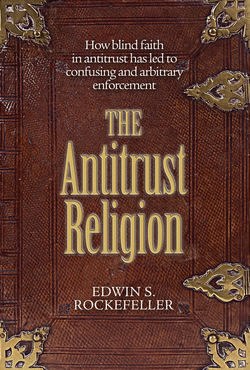Читать книгу The Antitrust Religion - Edwin S. Rockefeller - Страница 9
На сайте Литреса книга снята с продажи.
Futility of Reform
ОглавлениеAttempts at reform or repeal of the antitrust statutes are futile as long as faith in Antitrust with a capital “A” is preserved. Provisions of the antitrust statutes contain words without definition, but, except when amended by Congress, at least the words are fixed. One can look them up and write them down. Antitrust, the mystique, is a different matter. One cannot look it up. Joel Klein, while serving as assistant attorney general in charge of the Justice Department’s antitrust division, described the antitrust laws as “common law statutes.” He said to a meeting of antitrust lawyers, “You know, so much of litigation in the Supreme Court, or whatever, will be on what exactly are the words of the statute. But in antitrust it really is much more dynamic.”27
The antitrust lawyer must learn a special vocabulary not found in the U.S. Code. Observable phenomena are described by metaphors, which are not scientific labels of real-world data but artificial concepts, like “market” and “market power.” Antitrust experts speak a sort of poetry. Journalists and politicians take it as a description of reality. The public is confused. Antitrust concepts give a sinister characterization to the ordinary phenomena to which they are applied. “Oligopoly” is a good example. People who are learned in antitrust vocabulary know that an oligopoly is simply any number of sellers more than one—a common situation, but it sounds to the average citizen like a nasty condition and cause for concern.
Fashions in antitrust concepts change even when the statutory words don’t. Some terms achieve acceptance for a time but then lose their appeal and are abandoned. “Reciprocity” is a good example. At one time the FTC chairman saw reciprocity as an evil of great potential, warning that it “could result in closed-circuit markets from which medium or small factors are excluded” and, “thus oligopoly would be magnified in a sort of circular integration fashion … foreclosing the opportunities of firms without substantial market power to gain access to the inner circle of firms.”28 At about the same time, the head of the Justice Department’s antitrust division stated that “there is a legitimate basis for attacking reciprocity, not only under section 1 of the Sherman Act…butalso under section 2 … as an unlawful attempt to monopolize.”29 Some hand wringing occurred, but the attack never came. Eventually, it became clear to everyone that the nation is not in any danger if businesspeople tell each other: “I’ll buy from you if you buy from me.” Also, the word got around that it isn’t a very effective way to do business anyway, so we just don’t hear much about it anymore.
“Conglomerates” had a longer run as antitrust witches. Having succeeded in obtaining Supreme Court declarations that virtually all mergers of competitors as well as those of customers and suppliers are prohibited by section 7 of the Clayton Act, the government harassed “conglomerates.” In addition to court proceedings to prevent corporate acquisitions by conglomerates, both the FTC and the Justice Department conducted highly visible investigations of those that merely existed. The campaign was eventually abandoned. Many of the most feared “conglomerates” later shed their acquisitions or went out of business altogether without any help from government.
A key concept that currently has a firm grip on the imagination of the antitrust community is the concept of “market power” (see chapter 4). “Market power” is an imaginary concept borrowed from theoretical economics. It incorporates assumptions and predictions but is used by the antitrust community as though it describes facts subject to proof.
Antitrust as faith endures not because it has a fixed basis in science or reason but because it does not. Faith in antitrust allows the pursuit of mutually exclusive goals. It serves the human desire for both justice and “fairness.” The attempt to rationalize antitrust as consumer welfare economics has eliminated some of the glaring irrationality of interpretations of the antitrust statutes. Antitrust doctrines have been tidied up, but no amount of economic theory can resolve the basic conflict inherent in the human desire for both efficiency and fairness—goals that are often incompatible. The antitrust religion allows the pursuit of both goals simultaneously. It also avoids facing three real issues: (1) how to state a normative rule that distinguishes between contracts that unreasonably restrain trade and those that do not; (2) how to distinguish between willful acquisition of “monopoly power” and being an effective competitor; and (3) how to tell whether a merger may substantially lessen competition.
The generality and ambiguity of the antitrust statutes allow arbitrary decisions disguised as findings of fact. Market efficiency requires no government interference on its behalf. Fairness does. Antitrust allows the decisionmaker freedom to intervene on the side of fairness when he wishes to do so. The decision is not dictated by any objective measurement but by labeling as findings of fact theoretical concepts such as “the market” and “market power.” Unstated assumptions and predictions are incorporated into conclusions stated as facts, and then doctrines dictate the result. To maintain an appearance of a rule of law, the decisionmaker portrays the process as a factual inquiry followed by findings of fact to which rules are then applied. Actually, the result is dictated by the assumptions and predictions. Where one comes out is determined by where one starts in. Assumptions and predictions cannot be proven. They are subjective judgments in which the decisionmaker’s personal sense of fairness cannot be ruled out.
